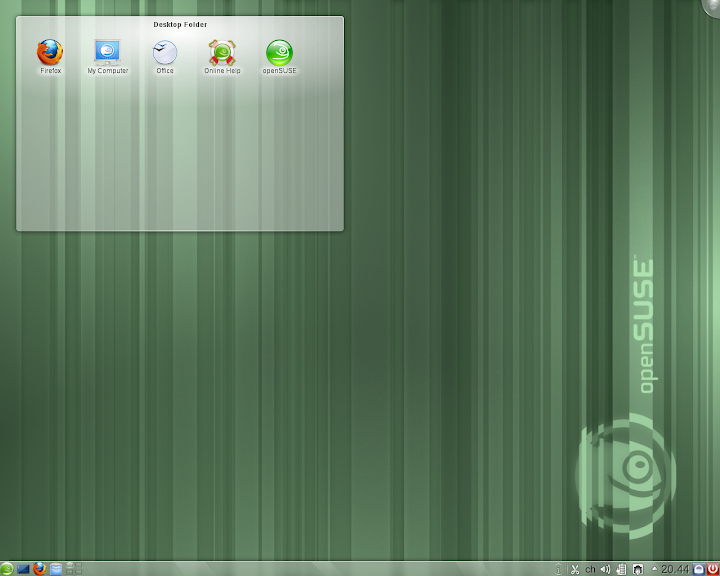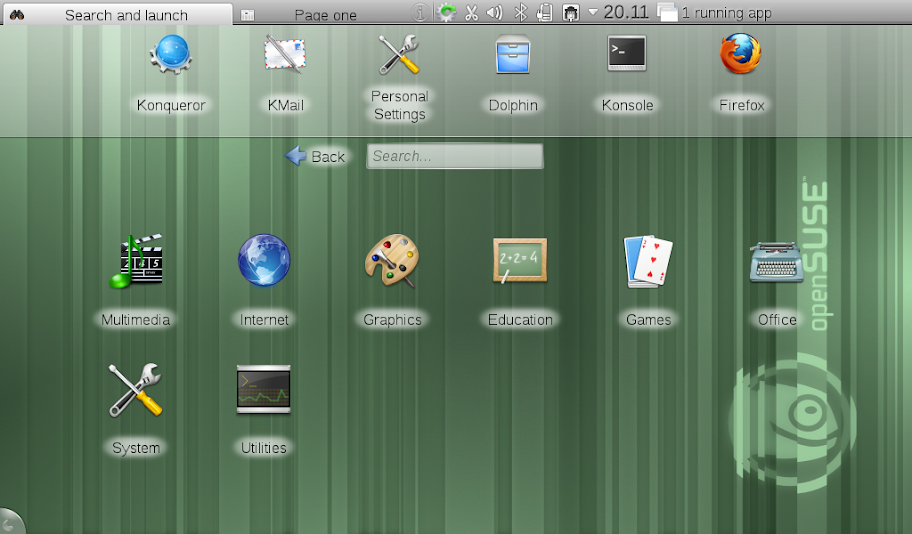openSuSE 11.4 Released (Updated)

As I mentioned a few days ago, this is going to be an interesting and exciting time in Linux distributions, with a lot of new releases in the works. The first of those, openSuSE 11.4 arrived today. I have been watching this one particularly closely, and testing it since the first Milestone release was available, because it is the first of a wave of releases which will properly support some of the newest netbook systems I own. Now that it is out, I am not disappointed. It has handled everything I have tried it on so far with very little trouble, and the few times there was a hiccup, it was easy to find and fix. I have been installing, testing, using and otherwise investigating openSuSE for a pretty long time now, and it just keeps getting better and better.
Check the Release Notes for details about what's new and improved, and get the LiveCD or full DVD images from the Download Page. So, what does it look like? Here is the standard KDE desktop, taken from a 1280x1024 external display connected to my Lifebook S6510:

At the other extreme, here is the KDE Plasma Netbook desktop, taken from the 1024x600 display of my beloved HP 2133 Mini-Note:

I'm going off on a short detour here, but... I really, really like the KDE Netbook desktop. It is just clean and easy to use. I always compare it to the Ubuntu Netbook Edition, which is probably the best known Linux netbook desktop at the moment. The Ubuntu Unity desktop has a vertical bar that contains icons for launching applications and utilities. When there is not enough vertical space to display all of the icons, they are "folded", sort of like an accordion, which makes them harder to see, and much harder to access. On netbook computers, with limited vertical space, a LOT of the icons get folded, and using the bar becomes very tedious, to say the least. Also, I find Unity difficult to modify or customize (well, impossible so far, to be honest, because I haven't figured it out yet). With the KDE Netbook desktop, everything is much more accessible (and much more obvious), and it is very easy to modify things you don't like.
Ok, enough of a detour, back to your regularly scheduled quick first look:
As always, especially with openSuSE, there are lots of updates, improvements and new packages in this release. Starting right at the top with Linux kernel 2.6.37, KDE 4.6, Gnome 2.32, X server 1.9.3. At the application level, the big news is that it has LibreOffice 3.3.1 - this is the first distribution fallout I have seen as a result of the Oracle/OpenOffice furor. It also include Firefox 4.0 Beta 12, which will of course be updated to the final 4.0 release as soon as that is available. There is a lot more new stuff, both at the system and application level, but honestly, is there a point to me sitting here and rambling off a bunch of version numbers? The complete details are in the release notes, linked above.
I have already installed it on six of my laptop/netbook systems, here are a few quick plus and minus notes that I made:
Fujitsu-Siemens Lifebook S6510 - Intel Core2 Duo cpu, Intel 965 graphics, Intel 5300 WiFi: Absolutely no problems with installation and configuration. All hardware detected and supported.
HP Pavillion dv2-1010ez - AMD Athlon Neo cpu, ATI Radeon HD3410 graphics, Atheros AR9285 WiFi: The KDE Live CD didn't boot properly on this system, it just hung with a blank screen. To get around this you have to press F4 at the openSuSE splash screen, and then enter "nomodeset" in the boot options line. This is only a problem with the LiveCD, the installed image on the system works just fine. This is apparently a known problem with "older" ATI and nVidia graphic controllers. Once I got the LiveCD to boot, there were no other problems with installation and configuration.
Lenovo Ideapad S10-3s - Intel Atom N475 cpu, Intel GMA 3150 graphics, Broadcom 4313 WiFi, Synaptics ClickPad touchpad: No problems with installation and configuration. This is the first distribution that has supported the Broadcom 4313 out of the box with the new brcm80211 driver, and it works great. Likewise, this is the first that I have seen that correctly handles the "buttonless" Synaptics ClickPad, thanks to the latest Synaptics 1.3.0 driver. In fact, this works so well that if it had come along a week or so sooner, I might not have bought the new Samsung NF310... well, no, I probably would have, but I would have felt a lot more guilty about it...
Samsung NF310 - Intel Atom 550 Dual Core cpu, Intel GMA 3150 graphics, Broadcom 4313 WiFi: No problems with installation and configuration - no surprise, as this netbook is nearly identical to the Lenovo above.
Samsung N150 Plus - Intel Atom 450, Intel GMA 3150 graphics, Broadcom 4312 WiFi: What a dream come true. Nothing to do but load and go, everything works. Everything, up to and including the Broadcom 4313 adapter. Welcome to "the nightmare of Linux device drivers", and have a nice day.
HP 2133 Mini-Note - Via C7-M cpu, Via Chrome9 graphics, Broadcom 4312 WiFi: This one was the "most trouble", which it always has been because of the unusual chips used in it. But it is still one of my favorites, and I am still impressed by how well it works. Being "the most trouble" means that it took me about 30-45 minutes to set it up, rather than just the 10-15 minutes it took to install openSuSE 11.4. The problem(s), of course, were the Chrome9 graphic adapter and the Broadcom WiFi adapter. When you boot the LiveCD, it doesn't have a driver for the Chrome9, so it falls back to VESA in 800x600 resolution - pretty awful looking! But no worries, don't panic, just persevere and get the installation done. It looks bad, but it is the same old installation, and it takes 10-15 minutes, like all the others. Once it is installed and you have booted it, make sure you have a wired ethernet connection, and then start Firefox. Go to openSuSE Software Download, and enter openchrome in the Package Search box. When the result comes back with one package found, click "1-click install" at the right of the window. Follow the procedure as it is presented to you, clicking "Yes", "Next" or whatever as necessary. This will take about 10-15 minutes, because not only will it install the openchrome driver, it will also install all of the other packages that have been pre-selected for addition to the LiveCD distribution. Once that is done, all you need to do is restart the X server (use whatever way you know how - kill the running server, logout, reboot, whatever). When the server restarts, it will be in 1024x600 mode, as shown in the screen shot above! Hooray! Next, the firmware for the Broadcom 4312 needs to be installed. Once again, no worries. Start a terminal (Konsole), su to root, and run /usr/sbin/install_bcm43xx_firmware. This one will only take about a minute. When it is done, reboot and the WiFi will be working. Hooray again!
All in all, this is an excellent release, and I am very impressed with it. Whether you're new to Linux or an experienced user, it is definitely worth a try. As I said in the beginning, I'm amazed and impressed that the openSuSE developers keep making this distribution so much better with every new release.
jw 10/3/2011